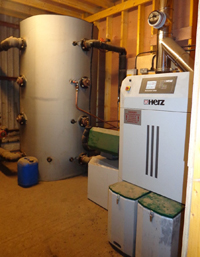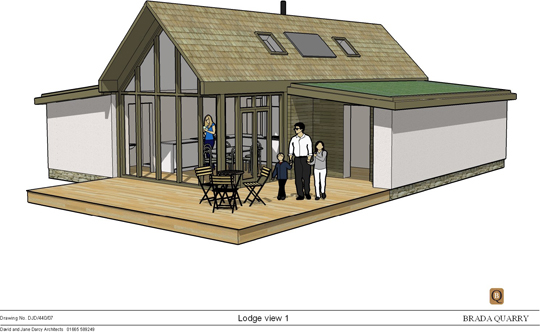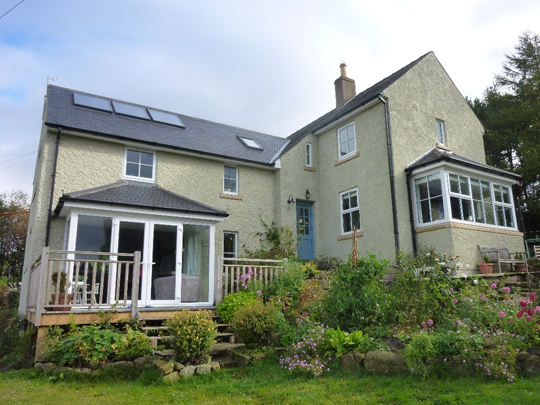Despite the presence of a pair of high pressure gas mains which cross North Northumberland from North to South, the route of which can be identified by swathes cut through woodland and red and white striped poles at field boundaries, there are few areas which have a domestic gas supply. Until the last few years, as a micro practice working primarily in the local rural area this meant that we had to specify oil fired boilers. Whether we were working on alterations and extensions to existing houses, a barn conversion or a new house, our domestic clients expected a traditional wet central heating system, with automatic operation and electronic programming.
Oil boilers require little physical effort in normal conditions, with many users relying on a Signalman to automatically request deliveries from suppliers, but in the winter of 2011/2012 there was a sudden problem. Although oil users had seen the price rise steadily since 2000, reaching a peak every winter and dropping back a little in the summer, oil had always been available if you were prepared to pay the price, which reached 70p per litre in December 2011. In addition to the high price, the cold and very icy conditions prevented suppliers from making deliveries to certain areas, and as they had problems fulfilling orders, so the delivery periods lengthened. Some customers were forced to buy oil in gerry cans, which could be picked up or delivered to the nearest accessible point, at a price, and some just ran out.
Renewable Heat Incentive
 Since then we have not specified an oil boiler, and a variety of domestic clients with varying projects and needs have chosen to heat them without oil. The start of the commercial Renewable Heat Incentive (RHI) encouraged clients with a large listed Georgian farmhouse undergoing refurbishment and extension to install a small biomass district heating system, heating the house, the laundry and tack room of a stable complex, office premises and a separate cottage. This system, designed and installed by specialists, utilises a 100kW boiler fed mechanically from a 50m³ woodchip bin feeding a large buffer tank, all in a nearby farm shed with underground insulated primary circuit distribution to heat exchangers in the separate buildings. A contractor brings specialist machinery to chip the owner’s wood and then farm machinery is used to move the woodchip from a separate covered store to the bin beside the boiler.
Since then we have not specified an oil boiler, and a variety of domestic clients with varying projects and needs have chosen to heat them without oil. The start of the commercial Renewable Heat Incentive (RHI) encouraged clients with a large listed Georgian farmhouse undergoing refurbishment and extension to install a small biomass district heating system, heating the house, the laundry and tack room of a stable complex, office premises and a separate cottage. This system, designed and installed by specialists, utilises a 100kW boiler fed mechanically from a 50m³ woodchip bin feeding a large buffer tank, all in a nearby farm shed with underground insulated primary circuit distribution to heat exchangers in the separate buildings. A contractor brings specialist machinery to chip the owner’s wood and then farm machinery is used to move the woodchip from a separate covered store to the bin beside the boiler.
Biomass boilers
A second re-occurring strand is the new or converted smaller house on a farm, built for the next generation of the family, which, being designed to current standards has a much smaller heating load than a traditional farmhouse or cottage. The farm provides a source of wood, space for wood processing and storage, machinery for transportation and occupants used to physical labour. A new build farmhouse has just been completed with a 20kW log gasification boiler providing water and space heating to the house. The boiler require stoking by hand, but is fired intermittently; it burns very efficiently at high temperatures, transferring the heat energy to a 1500l buffer tank, the water from which is then blended to provide domestic hot water and space heating. Once the boiler is loaded the system works no differently to any other central heating system. The boiler, tank and wood storage require considerably more space than an oil fired system, but that’s not a problem if we are aware of it at the design stage, and the farmer client started cutting and storing his own wood before the build began on site. Having completed one of these systems we have another project which is suitable, this time a conversion, and we can use the first house to show the clients how it works. At the same time that biomass boilers have become more widely available, the availability of a greater choice of engineered floor joists and underfloor heating systems has made it easier to use a low temperature heating system throughout the house which makes efficient use of the heat source.
Northumberland is traditionally an area where the locals are prepared to work physically and to put on an extra jumper when it gets cold
Thirdly we have worked with several clients who have not insisted on a fully controllable central heating system. Northumberland is traditionally an area where the locals are prepared to work physically and to put on an extra jumper when it gets cold, for example a vet and his family, with a smallholding, who lived outdoors most of the time. Taking the plunge to extensively rework and extend their home and remove the existing central heating, relying on an electric Aga, wood burning stove and solar thermal water heating has been very successful, although the desired wind turbine has not been possible yet. The dramatically increased thermal performance of the extended house in comparison with the original dwelling is a major part of the equation, also perhaps their experiences living in New Zealand where central heating is not as common.
The generous PV subsidies offered in the winter of 2011/2012 also encouraged several clients, mostly couples on the verge of retirement, to install a PV system. In the case of a couple moving back from South Africa into an old cottage, they just weren’t used to central heating, and preferred the mix of a wood burner, electric heating, PV panels and fortunately good levels of solar gain.
Designing for individuals
The element in common with all these projects is that they were homes specifically designed for individuals, who could tell us how they lived and what they wanted. Our own home is a converted mill with no central heating; we have a wood burning stove in the open plan living space, cool bedrooms, secondary electric heaters in the bathrooms, and a whole house ventilation system. It has been a healthy and comfortable house to live in, although it requires considerable physical effort in the winter months, organising wood and stoking the stove, and despite high levels of insulation, would probably not reach a decent SAP rating under current regulations, due to the lack of controllability. At times we have also found it difficult to maintain a consistent supply of wood, although increasing demand has brought more suppliers into the market.
We have one project using biomass heating which is not a single home for a specific client; Brada Holiday Village is a development of 22 straw bale holiday lodges situated close to Bamburgh in the North Northumberland Coastal AONB. The lodges are compact; three bedrooms open directly off an open plan kitchen/living space with a central masonry chimney stack housing a wood-burning stove and a small amount of secondary electric heating to frost protect in winter and provide background heat before visitors arrive. Our recent experiences with biomass mean we can steer our rural clients away from oil, and show them how the alternatives work. We work on the principle that fabric comes first, thermal mass is important in a building with radiant heating and you should insulate your home as well as you can.

... the government’s financial support for biomass is an incentive to take some risk in installing a system for which there is still a maturing market.
Our recent experiences with biomass mean we can also steer our rural clients away from oil, and show them how the alternatives work. The background that makes this possible is firstly that all our local clients know someone with a horror story from the cold winter of 2011/2012 when the oil ran out, and secondly that the government’s financial support for biomass is an incentive to take some risk in installing a system for which there is still a maturing market.


